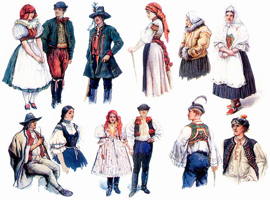
|
The Society of Folk Dance Historians (SFDH)
Costumes of Moravia
[
Home |
About |
Encyclopedia | CLICK AN IMAGE TO ENLARGE |

|
 In the amazing patchwork of cultural distribution, there is an occasional combination of factors that creates a culture unusually rich in folk art and tradition: a mixture of cultures nurtured by a benevolent environment.
In the amazing patchwork of cultural distribution, there is an occasional combination of factors that creates a culture unusually rich in folk art and tradition: a mixture of cultures nurtured by a benevolent environment.
Several such areas are found in Europe. Nowy Sącz in Southern Poland has a folk costume that combines elements of Krakow to the north and the Gorali of the Tatra Mountains to the south, culminating in what must be Poland's most highly developed costume. Certain areas of the Tyrol of western Austria and southern Germany have costumes far more elaborate and highly decorated than those of their Tyrolean neighbors.
One of the most notable of these regions is Southern Moravia, home of the so-called "Moravian Slovaks." In this corner of the old Austro-Hungarian Empire, cleared of any "non-Moravian" peoples since World War I, the population lives in a fertile agricultural area, with good soils and drainage, forming a gently rolling landscape heavy with crops and a strong agricultural tradition.
Living in an area bounded on the north and west by mountains, on the South by Austria, and on the east by Slovakia and Hungary, the Moravians (a people of Czech origin), have been subject to a muiltitude of cultural influences. The result has been a rarely-achieved level of folk art.
An excellent opportunity to see this unparalleled folk art is at the annual Folk Festival of Strážnice, held near the end of June each year. There, one is caught breathless again and again as impossibly ornate costumes appear – women's enormous skirts, starched petticoats, and pleated sleeves, and the men even more ornate in embroidered, tight-fitting pants, tasseled boots, and enormous sleeves embellished with ornate cutwork embroidery.
The basic costume of South Moravia is similar to Hungarian costumes, but the aesthetics of the region dictate a more intense treatment. Elaborate embroidery replaces flat braid. Heavily starched pleats reshape modest blouse sleeves into major fashion focal points. Hand painted ribbons hang from the men's jacket fronts to share in the instep with enormous tassels. Huge rooster feathers and flower arrangements adorn already heavily decorated hats. It's as if the artistic drive didn't know where to end!
The towns of Uherské Hradiště ("little Hungarian castle") and Uherský Brod ("Hungarian [river] ford") lie along the northern edge of south Moravia. The best known costumes there are the women's, identified by enormous pleated sleeves, starched and stuffed with tissue, and gathered at the elbow. These stand prominently above brocaded skirts and aprons. In some villages, notably Vlčnov, red-orange tassels the size of apples decorate the front and back of both men's and women's vests.
The nearby town of Kyjov is justly famous for its costume. The women's white blouses are heavily embroidered in black eyelet and the wide collars are backed in magenta fabric, exquisitely highlighting the embroidery. The red-orange pleated skirts are covered by black aprons edged with lace and embroidered with colorful sprays of flowers. There, too, we see the famous women's pleated boots. Men in Kyjov are only a little less flamboyant, with their tight black trousers lavishly embroidered with soutache (narrow flat decorative braid), and their semi-full sleeves embroidered in the same way the women's blouses are done.
Further south, near the towns of Hodonin and Břeclav, the costume embellishment reaches its extreme development. The men are the more flamboyant there, wearing tight red trousers, heavily embroidered in purple and yellow, short vests elaborately decorated with rouching (gathers that are not sewn into a straight edge) and hand-painted flowers, and each sporting four ankle-length hand-painted ribbons in front. The shirts' wide sleeves are heavily embroidered with cutwork embroidery, and purple tassels adorn embroidered, brass-heeled boots. Women's costumes vary a bit more than the men's, but are characterized by very wide skirts, aprons lavishly embroidered with flowers or cutwork embroidery, and tight brocade bodices confining heavily cutworked blouses. Pleated, brass-heeled boots are worn.
The Moravian Slovaks offer a treasury of the ulitmate development in costume adornment in European folk costumes. In some areas, it seems that the artist could not stop, continuing to add more pieces of the costume to decorate. Happily, modern versions seem to have retained the quality of workmanship seen on museum pieces. One can only hope that the interest in preserving this precious folk art continues.
DOCUMENTS
- Moravia, a region.
- Richard Duree, an article.
Used with permission of the author.
This page © 2018 by Ron Houston.
Please do not copy any part of this page without including this copyright notice.
Please do not copy small portions out of context.
Please do not copy large portions without permission from Ron Houston.